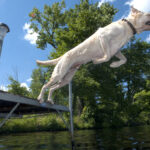
The Problem with Purely Positive/Force Free Training #1 – Intro
In this series of articles I speak to some of the common thinking errors and myths perpetrated by the purely positive or force free type training community. Allow me to preface this series by saying that I am well aware of how to use a clicker, treats, toys, manage thresholds, stimulation, and motivation in dog training. In fact I use many of these training tools in my own practice often in concert with other techniques.
In this series of articles we examine this topic in depth. I will endeavor to use many real world examples to illustrate my points and keep things interesting.
You just bought a puppy or brought a dog home from the shelter and it’s time to look into getting your new four legged friend some training. A quick google search and you start seeing certain phrases repeat themselves on almost all the training websites and blogs you go to.
Positive training, force free, clicker training, science based, free shaping, and I am sure some others I am forgetting. You are new to this whole training thing or maybe you have been through a class with a previous dog, either way your interest is piqued. You call up one of these trainers or do some more research on google.
The basic themes you quickly pickup from your research is that the only way to properly train your new dog is through positive reinforcement exclusively using motivation and removing all forms of punishment or corrections. Any form of punishment or correction is abuse and violence. Punishment elicits pain and fear. Good trainers do not need pain and fear to train dogs. Dogs are our friends and we don’t hurt our friends. Science has proven dogs learn more quickly through motivation and positive reinforcement. All positive training is science based and any training that incorporates corrections is stone age Neolithic barbarism that should be condemned.
If that doesn’t convince you or scare you away from any alternate form of training I don’t know what will. The truth is most dog owners don’t even bother with anything more than the most perfunctory research. They read or hear some form of what I wrote above and take it as gospel. Let’s not forget the fact that most people love their dogs like family and the thought of only training with love and treats is appealing in and of itself.
These people sign up for such training and results are often inconsistent or non-existent when they have their dogs out in the real world. After all, they have been assured online or by their trainer that there is no other way to train a dog. So, what else can they expect or do?
Most dog owners make do with problem behaviours, inconsistent obedience, and just learn to manage. Things aren’t perfect but hey, you love your dog and are willing to make some sacrifices to your life style. Or worse, your dog develops serious or dangerous behavioural issues and you end up having to isolate, rehome, or even put the dog down.
I am here to tell you that all that stuff you were told or read is misleading, incomplete, or utter lies. I often compare purely positive / force free type training to the type of parents who started cropping up in the 60s that advocated against disciplining children in any way, making every experience happy and positive and sheltering the children from any kind of responsibility or adversity. After all, the results of such an approach in dogs and children are often the same.
Unfortunately, I do not have the time to write the book this topic deserves however I will attempt to speak to a lot of the issues, errors, and results of purely positive / force free type training. I will be writing a series of articles to discuss this topic in depth.
Stay tuned!
Share:
Recent Post

Avoiding Common Dog Dock Diving Mistakes
Dog dock diving is a thrilling activity that strengthens the bond

Can All Dogs Swim?
As dog owners, we often marvel at our pets’ abilities and

Haz Othman Obedience training workshop – MARCH 11-12
Hey guys, I will be holding our first Power Obedience Seminar
